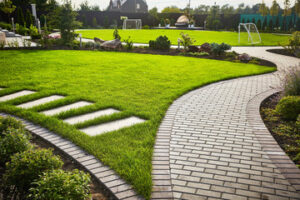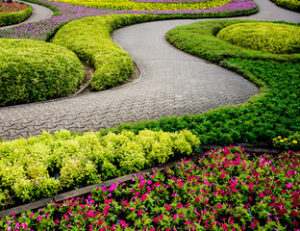Landscaping is a more expansive form of gardening that incorporates both structural and natural elements to enhance usability, beauty and utility. Plants, lawns and trees provide environmental services such as air and water filtration and shade, while hardscape features like pathways, patios and retaining walls define space and support outdoor living.

The landscape design process is a critical step in transforming an outdoor space into a functional garden or backyard retreat. A well-conceived plan can enhance property value, reduce maintenance costs, and improve aesthetics. While there are many elements to consider, starting with a few simple principles can help homeowners create their dream yard. Contact Landscaping Fayetteville AR for professional help.
Lines are a key design element that can be used to create focal points with landscape features like gardens and water features. Whether it’s a perceived line created by the placement of objects, or a physical path or walkway, lines guide the eye and add structure to a design.
Texture and color are also important elements in landscape design. Using different textures to create depth, and selecting colors that complement each other can make an impactful statement. The use of lines, color, and texture can also be used to create visual movement. This can be achieved by incorporating movement-inducing plants and features into the landscape, such as koi ponds, waterfalls, or fountains.
While incorporating practical considerations into the design is important, it is also vital to allow for personal preferences when creating a landscape. Choosing plants and flowers that you love will add a personal touch to your backyard, and can make your garden feel more like home.
The use of a variety of plant species can add diversity to your landscape, and help maintain healthy soil. It is also beneficial to incorporate a mix of both deciduous and evergreen trees, to provide shade, color, and seasonal interest.
Plants and shrubs can also be used to create barriers in the landscape, by blocking views or access to a desired area. Low-growing plants are a good option for this, as they can be used to block both sightlines and access while still maintaining an open feel.
Adding hardscapes to a landscape can bring a sense of elegance and sophistication, and is an important part of the overall design process. Pavers, flagstone walkways, custom concrete work, outdoor kitchens, fire pits, and more can all be integrated into the landscape to create a cohesive and functional outdoor space.
Materials
Have you ever been mesmerized by your neighbor’s perfectly manicured lawn, a gravel pathway artistically paired with charming garden furniture, or the grandeur of a stone retaining wall holding back a hillside of lush greenery? Well, there’s a science behind those mesmerizing outdoor landscapes. And it all starts with the right materials!
Landscaping involves two types of components: softscaping and hardscaping. Softscaping refers to your landscape’s living elements, like trees, shrubs, flowers, and grass. This includes any greenery that covers the ground, as well as water features like waterfalls and fountains. Hardscaping, on the other hand, refers to the nonliving structures in your yard, such as patios, walkways, and retaining walls.
Choosing the right materials for your landscaping is vital for achieving your desired results and ensuring the longevity of your investment. When choosing landscaping materials, be sure to consider their durability, cost, and environmental impact.
Common landscaping materials include soil, mulch, lights, fencing, retaining wall blocks and edgers, gravel, pavers and bricks, sand, and plantations. Using reclaimed and recycled materials is an eco-friendly option that reduces waste and the need for new materials. It also helps keep costs down and creates a sense of place.
Soil is an important component of any landscaping project as it provides the foundation for your plants and ensures proper drainage. Mulch helps prevent weed growth and transfers nutrients to the soil. Gravel is a durable material that works well for creating pathways and defining garden beds. Pavers and bricks are a stylish alternative to concrete for creating walkways, driveways, and patios. Sand is essential for laying pavers and is used to level the surface before installing other landscaping elements.
Wood is another popular landscaping material that can be used for fences, gates, benches, and other structural components. It offers a warm, natural feel and blends well with most surroundings. However, it is prone to rot and termite infestation and requires regular maintenance. Alternatives to wood include composite wood, which is made of recycled materials and has a more durable appearance. Another great option is corten steel, which has a beautiful rustic look and is resistant to weather damage.
Installation
The installation of landscaping combines creativity and practicality to maximize the potential of outdoor spaces. It can be used to create serene gardens, comfortable outdoor entertainment areas, or healthy lawns and greenery. The practice includes the planting, arrangement, and maintenance of plants, trees, and shrubs as well as the alteration of terrain through grading, mounding, and shaping to improve drainage and usability. In addition, it involves the integration of nonliving elements like ponds, rocks, walkways, patios, fences, and outdoor lighting into the landscape design.
A professional can help you design and construct an appealing outdoor space that reflects your unique vision and matches the architecture of your home. They can also take into account climate, sun conditions, soil, and plant species to craft a design that is both functional and visually pleasing. If you’re planning a large-scale project, it’s important to understand whether it requires official permits. This is especially true for projects that may interfere with or affect waterways, draining systems, and natural resources.
While some aspects of landscaping are simple and easy to do, it’s essential to hire a licensed and experienced professional to ensure your project is completed correctly and safely. They can help you select the best materials and plants for your climate, and provide tips on how to maintain them. They can also help you navigate any legal requirements and regulations that apply to your property.
There are many different types of landscaping services available, from simple lawn care to the construction of more elaborate features. These features can increase your property value, add privacy and security, and make your outdoor space more functional. Some of these services include:
Landscaping can be a complex process that requires the assistance of professionals. Whether you’re looking for a company to provide routine lawn care or to install more extensive outdoor features, it’s essential to find one that is licensed and insured. This will help to protect you from scams and ensure that your project is carried out properly. The licensing requirements vary by state, but typically involve a background check and a physical exam.
Maintenance
Landscapes require ongoing maintenance to preserve their beauty, health and functionality. Professional landscapers offer a range of services to maintain your property, including pruning and fertilization, seasonal adjustments, pest control, and weed management. They also perform landscape installation and water management to ensure that your garden thrives.
Landscape design often starts with a thorough terrain assessment. Then, professionals recommend how to use the space and determine whether any structural elements should be integrated into it. For example, a homeowner may want to build a patio or outdoor kitchen to increase the usability of their yard. A pond or waterfall may be added to add visual intrigue and sound, or plants like tulips and daffodils can provide color.
Choosing plants that are well-suited to your climate and soil conditions is key to low-maintenance landscaping. Native plants tend to be more resilient and adaptable, so they’re less likely to suffer from disease or insect infestations. Other landscape elements that require less upkeep include grasses, groundcovers and shrubs. You might also consider adding natural areas of woods or wetlands for more shade and wildlife habitat.
Landscaping is different from gardening in that it includes both the cultivation of living plant materials and the modification of the outdoor environment through structures, such as walkways, patios and retaining walls. This helps to define the outdoor space and make it more functional for relaxing or entertaining.
While the primary goals of gardening are usually personal satisfaction and growing food, landscaping is more about improving the appearance of an outdoor space and increasing property value. When done right, a well-maintained lawn and gardens can have a positive impact on your property’s value, curb appeal and overall quality of life.
Whether you’re looking for commercial landscaping services or residential, Complete Landscaping Service can help keep your property looking its best all year round.
